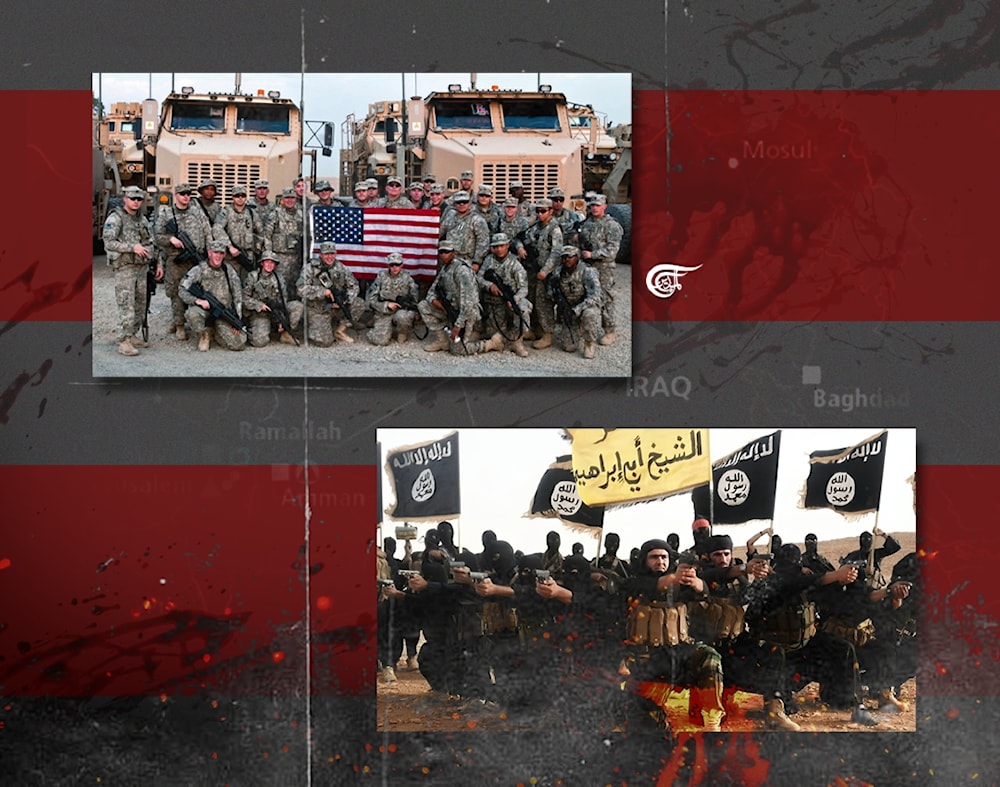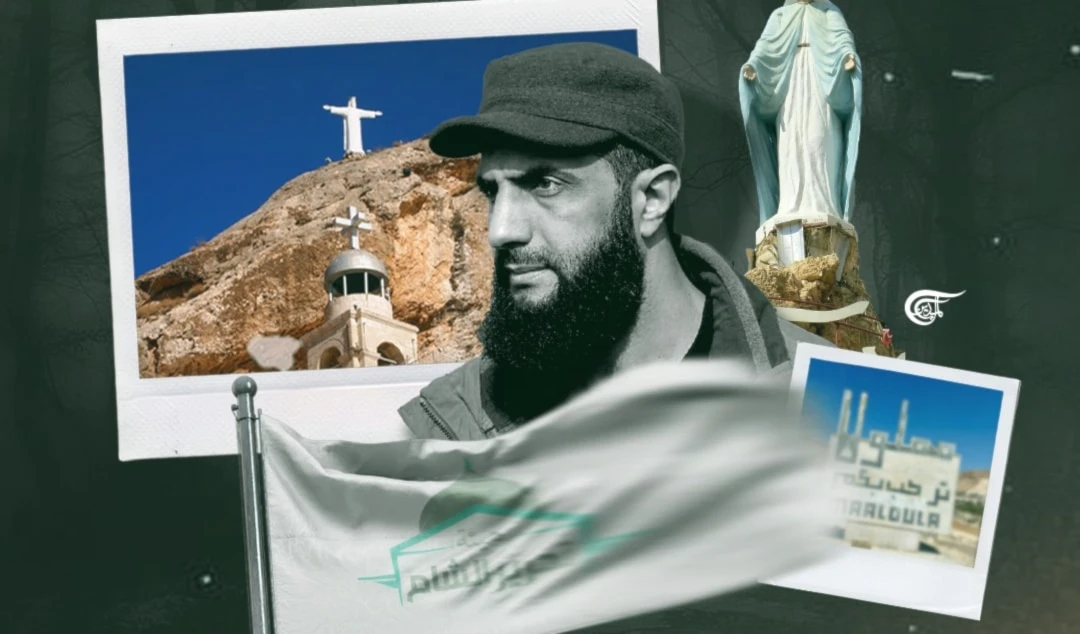String of US and Israeli assassinations further inflame the Middle East
The US and "Israel" have been recently carrying out political assassinations in Syria, Lebanon, and Iraq. ISIS carried out a massive bombing in Iran during the same period, and there is a connection between ISIS and the US.
-

What is the connection between ISIS and the US? (Al Mayadeen English; Illustrated by Zeinab El-Hajj)
On December 25, 2023, Razi Mousavi, a senior officer in Iran's Islamic Revolutionary Guard Corps (IRGC) was assassinated by an Israeli airstrike in the Syrian capital of Damascus. Mousavi was close to former IRGC Quds force commander, Qassem Soleimani, who was assassinated in 2020 by US President Donald Trump in Baghdad. Israeli airstrikes in Syria earlier in December also killed two other Iranian generals.
On January 2, an Israeli drone strike assassinated Saleh al-Arouri in Beirut, Lebanon along with six others.
Al-Arouri was the deputy chief of the Hamas political bureau, and one of the founding members of Hamas’ armed wing, the Al-Qassam Brigades. On October 31, Israeli forces destroyed al-Arouri’s house in Aroura near Ramallah in the occupied West Bank.
On January 3, at least 93 people were killed in twin bombings in Kerman, Iran, with 284 wounded, including children. The crowd there was gathered to mark the fourth anniversary of the US assassination of Qassem Soleimani.
On January 4, ISIS claimed responsibility for the two explosions in a statement posted on its affiliate Telegram channels, and said two ISIS members had detonated explosive belts in the crowd in Kerman.
Experts pointed to the Islamic State branch based in neighboring Afghanistan, known as ISIS-Khorasan, or ISIS-K. Tehran has alleged that ISIS-K has been behind many foiled plots in the last five years. Most of those arrested were Iranians, Central Asians, or Afghans from the Afghanistan-based affiliate's network.
On January 4, a US airstrike assassinated Mushtaq Talib al-Saidi in central Baghdad, Iraq. The Iraqi deputy commander was killed on Palestine Street, at the headquarters of an Iraqi military group, Harakat Hezbollah al-Nujaba, which has claimed several attacks on US forces.
Hezbollah al-Nujaba falls under the command of the Iraqi army, and had played a vital role in the defeat of ISIS in Iraq. The group immediately condemned the assassination of al-Saidi, and said the US-Iraqi military agreement had been violated.
Maj. Gen. Patrick Ryder, a Pentagon spokesman, confirmed that US forces carried out an airstrike in Baghdad, killing a military commander, but excused the killing because al-Saidi was backed by Iran.
Iraqis in the streets promised revenge against the US after the assassination. “No American soldier shall stay in Iraq!” one man yelled, firing his gun into the air.
Besides the 2,500 US troops in Iraq, which were invited to Iraq initially, there are 900 US troops in Syria illegally occupying the most productive oil wells in the northeast.
Now that the US-supported genocide on Gaza has killed well over 20,000 Palestinians, local groups in Iraq and Syria have been attacking US troops there in an effort to drive them out.
US officials have ordered about 120 attacks since October 17, usually using drones or rockets against groups in Iraq. The Pentagon acknowledged they had killed a number of “militants”.
Iraqi Prime Minister Mohammed Shia Al-Sudani, had said last year he backed the need for US troops in Iraq, but condemned the US attack in Iraq, which killed an Iraqi service member and injured 18 other people, including civilians.
On December 28, 2023, Al-Sudani announced his government was working to end the US military presence in Iraq. The Iraqi groups have been frequently attacking US troops in Iraq and Syria with drones and missiles. Al Sudani has said the US strikes are an “infringement to Iraqi sovereignty”.
“With the presence of capable Iraqi forces, the Iraqi government is heading towards ending the presence of the international coalition forces," said Al Sudani.
The Iraqi government had asked the US military to come to Iraq to help in the fight to defeat ISIS, which ended in 2017. Afterwards, the US remained in Iraq as trainers and advisors to the Iraqi military with several thousand troops remaining there. However, the agreement between the US and Iraq excludes military operations by the US troops.
Iraq’s military spokesperson, Yahya Rasool Abdullah, described the US strike as “no different from terrorist acts” and said that the Iraqi army held the US responsible for the attack on a Harakat Hezbollah al-Nujaba, which is under the Iraqi Army's command.
“We consider this targeting a dangerous escalation and an assault on Iraq, far from the spirit and text of the authorization and the work for which the international coalition exists in Iraq,” Abdullah said in a statement.
On January 3, 2020, US President Donald Trump ordered the assassination of Iran's most powerful military commander, General Qasem Soleimani, who was killed at Baghdad airport, along with others.
Soleimani was widely seen as the second most powerful figure in Iran after Ayatollah Khamenei. He was instrumental in the attack on, and the defeat of ISIS in Iraq and Syria. Despite the US propaganda, ISIS was defeated by Iraq, Iran, Syria, Russia, and the US-led coalition.
Who is ISIS, and who created them?
In an article published in 2015 in The Guardian, it was reported that the trial in London of a Swedish man, Bherlin Gildo, accused of terrorism in Syria, had been thrown out once the prosecution became aware that UK intelligence had been arming the same terrorists the defendant was charged with supporting.
The defense argued that there was extensive evidence that the UK government was supporting the very same terrorists, the so-called “armed opposition in Syria”. The evidence included UK support of the terrorists with body armor, military vehicles, training, logistical support, and the secret supply of “arms on a massive scale”. MI6 had cooperated with the CIA on a “rat line” of arms transfers from Libyan stockpiles to the Syrian rebels in 2012 after the fall of the Gaddafi regime, which was exposed in 2014 by investigative journalist, Seymour M. Hersh.
The UK ministers and their security officials were found to be supporting terrorists, and couldn’t very well ask the courts to imprison Gildo for doing the same. However, the UK was not alone, and they were only following the orders of US President Barack Obama, who was the architect of the US-NATO attack on Libya and Syria.
The Americans and their British allies used terrorists who were following the political ideology of Radical Islam as their boots on the ground. Obama called them the Free Syrian Army (FSA), and Senator John McCain became their biggest supporter in Congress.
The beginning of ISIS starts with the 2003 US invasion of Iraq. Previously, there had been no Al Qaeda presence there, but they came pouring in in response to the invasion for regime change. Al Qaeda took hold in Iraq, and by 2011 they took notice of the FSA in Syria who were getting weaker by the day fighting the Syrian Arab Army. Once the FSA was on the brink of annihilation, they put out a call for their brothers in arms, Al Qaeda.
Hillary Clinton admitted in an interview that the US had invented Al Qaeda in Afghanistan to fight the Soviet Army.
In 2012, the Defense Intelligence Agency, at the Pentagon, wrote a report predicting a coming principality following Radical Islam in Syria and Iraq. The report identifies Al Qaeda as the major force in the opposition fighting in Syria. By contrast, Obama and McCain, at the same time, were selling the American public on the story that it was “freedom fighters” of the FSA who were fighting the Damascus government.
The Pentagon report said that the supporters of the Syrian opposition (US, UK, France and NATO) wanted a principality governed by Radical Islam in order to isolate the Syrian government.
In 2013 ISIS was formed in Iraq, and their leader Abu Bakr Baghdadi later asked his associate Mohammed al-Julani to go to Syria and open an ISIS branch there. Julani went to Syria and called his group Jabhat al-Nusra, and soon the FSA were gone. Julani is now the man who controls Idlib province in Syria, and his superior, Baghdadi was eventually assassinated in Idlib by Trump.

 Steven Sahiounie
Steven Sahiounie
 8 Min Read
8 Min Read











